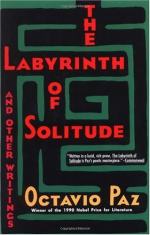
|
| Name: _________________________ | Period: ___________________ |
This test consists of 15 multiple choice questions and 5 short answer questions.
Multiple Choice Questions
1. How do Mexicans avoid the dangers of romantic relationships, according to Paz?
(a) By stifling their feelings.
(b) By exaggerating their feelings.
(c) By not truly loving.
(d) By denying the importance of the other.
2. Why did Catholicism drastically change the Aztec view of life?
(a) It saw life linearly rather than cyclically.
(b) It emphasized man's humanity and personhood.
(c) It placed a merciful God in charge.
(d) It placed man's salvation outside himself.
3. According to Paz, what is the Mexican's relationship with his fellow man?
(a) He changes him to Nobody.
(b) He respects him only if he is revered.
(c) He ignores him.
(d) He respects him only if they are the same social class.
4. In Paz's estimation, what vital word has the Mexican forgotten?
(a) The word that allows him to reach out to others.
(b) The word of love given to him by his mother.
(c) The word that gives him peace with all others.
(d) The word tying him to life forces of creativity and destruction.
5. In Paz's example of the village near Mitla, how is their yearly income spent?
(a) On weddings and christenings.
(b) On education.
(c) On funerals.
(d) On fiestas.
6. What is the difference between the Mexican killer and the modern one?
(a) The Mexican kills a man, not an object.
(b) The Mexican obliterates an object, not a man.
(c) Only the Mexican killer expresses true hatred.
(d) The Mexican kills as an expression of love.
7. Why are woman considered inferior people?
(a) They are too emotionally attached.
(b) They are not as reticent as men.
(c) They are not as intelligent as men.
(d) They open themselves up in submission.
8. What does the pachuco represent in Paz's writing?
(a) One step along the path that a Mexican can take.
(b) One extreme at which the Mexican can arrive.
(c) The modern-day religious saint.
(d) The typical Mexican living in North American culture.
9. What contributes to the power of the word, chingar, and all of its derivations?
(a) The fact that it is prohibited in public places.
(b) The fact that the word is related to words related to death.
(c) The fact that its derivations are many and complicated.
(d) The fact that people use the word in religious ceremonies.
10. What connotation does the verb, chingar, carry?
(a) Disaster.
(b) Violation.
(c) Failure.
(d) Mythical power.
11. In Paz's estimation, woman is a living representation of which of the following?
(a) Life overpowered by death.
(b) Man's incomplete nature.
(c) Life.
(d) The strangeness of the world.
12. When is the fiesta of Grito celebrated?
(a) September 15 at 11:00 PM.
(b) April 16 at 11:00 AM.
(c) August 3 at 9:00 AM.
(d) October 31 at 3:00 PM.
13. Why does the modern novelist rarely choose the worker as his protagonist?
(a) The worker cannot adequately capture what the novelist wants to convey.
(b) The worker is too recent and similar to his boss.
(c) The worker is not a universal figure.
(d) The worker is not modern enough.
14. What duality does the pachuco represent?
(a) A fiend whose trademark is hearty laughter.
(b) A saint deeply involved in scandal.
(c) A clown whose purpose is terror.
(d) A victim obsessed with revenge.
15. How did Paz consider his philosophical questions?
(a) As the only means to find answers.
(b) As meaningful only if they addressed the question of Mexican identity.
(c) As an excuse for not facing reality.
(d) As a waste of time.
Short Answer Questions
1. Above all other definitions, who is the Chingada?
2. As Paz begins Chapter Two, he says that the Mexican is always afraid to glance at his neighbor. What reason does he give for that?
3. What is the French sociologists' interpretation of the fiesta?
4. What analogy does Paz use to explain Mexico's history?
5. In Paz's view, why does the Spaniard still use and enjoy blasphemy?
|
This section contains 705 words (approx. 3 pages at 300 words per page) |

|




